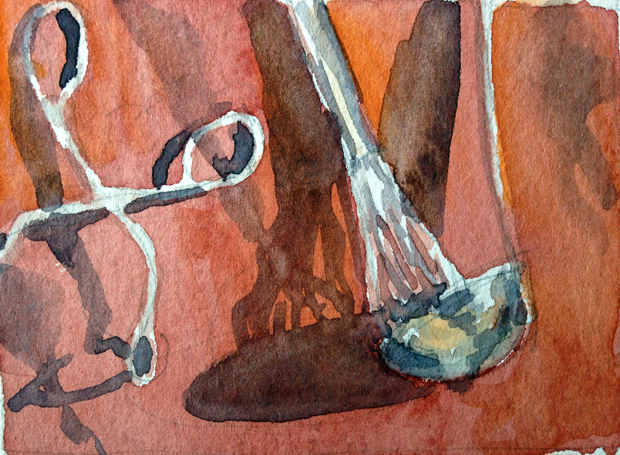For the third of this seasonal series, here is a bit of writing that emerged during last year’s Advent Restorying retreat. The beginning of the first sentence is a prompt, called a “story stem.” More on that at the bottom, if you want to try story stem writing. It’s a great way to dive into the depths of memory and emotion, past even that into the stream of archetypal consciousness that flows beneath us all.
I am a child at Christmas and everything is magical. We gather to trim the tree, laughing at the “scary” ornament — a rusty, wire-screen encased odd thing from Mom’s childhood.
History, deep connection with past generations, past Christmases.
We still use tinsel and enjoy tossing great handfuls of it on the fragrant boughs of the tree. There’s an actual, recently-alive tree in our living room.
Now it has lights twinkling in it. Those big, colorful bulbs that go off if one of them burns out.
Now presents begin to accumulate beneath the tree. The advent calendar, bought in Germany before I was born, stands on a side table. Or, this year maybe it’s on the piano. I love peeking behind the little doors to wee what surprise awaits.
I love that it gets dark so early now: the sooner we can put the tree lights on. And see how they reflect off the black glass of the picture window.
I just know we will always be together, just like this, every Christmas for the rest of my time here.
The experience of telling this story to two friends in the warmth of the woodstove surprised me with a beautiful insight that sustained me throughout the season. In April of last year, my mother passed, so this was to be the first Christmas without her or my father, who had passed the August before. As I told the story aloud to a listener, the final sentence tripped me, given the recentness of those losses.
My listener pointed out the deeper truth of it — that we were, truly, all together, everyone present, both in this one moment of recollection and in a soul sense. We had read and reflected the evening before on Mary Oliver’s poem, “Walking Home From Oak-Head,” and it provided a perfect phrase: “the lovely meaninglessness of time.” We are each living a long story, indeed.
If you want to try this yourself, the three story stem prompts are:
- I am a child at Christmas and . . .
- We travel at holiday time . . .
- One Christmas, everything changes when . . .
These are in the present tense. Try to keep what you write in the present tense, like you’re telling a story to a friend. This makes the story feel more immediate and, well, present, but don’t worry too much about how it comes out.
Write by hand for five minutes. It may help to set a timer, so you’re not concerned with the time. Try to keep your pen on the paper, moving, at all times. Don’t edit, cross out, or change things, just write.
It’s really fun to do this in a group of two or three people. After writing, sit facing each other and take turns telling the stories to each other. If you are three, one of you is the teller, one the listener, and one the observer. The listener simply reflects back what he or she has heard, key words, phrases, or emotions that were particularly strong. They might ask to hear a part of it, or even the whole story, again.
As the listener, avoid bringing it back to you; the phrase, “That reminds me of a time. . . “ is a clue that you may have slipped into that. The observer’s role is to watch both teller and listener, and pay attention to anything that might be going on beneath the surface, noticing possible themes in the collective experience. Body language, emotion, and your own intuition are good guides. Allow about ten or fifteen minutes per person, then switch roles to hear the next story. With three people, the whole process takes about 45 minutes.
Please leave a comment if you try this, and share your experience. Share your story, if you feel moved to! Enjoy the season.

